class: center, middle # Building Stateful Microservices With Akka <br /> <br /> <br /> <br /> <br /> <br /> .text-right[ .text-bigger130[ Yaroslav Tkachenko ] Senior Software Engineer at Demonware (Activision) ] --- # About me .left-column.column-35[  - Java, Scala, Python, Node - Microservices - Event-driven Systems - Distributed Systems - DevOps - ... [and more](http://sap1ens.com/files/resume-yaroslav-tkachenko.pdf) ] .right-column.column-65[ .text-center[ **Yaroslav (Slava) Tkachenko**, Vancouver, Canada ] <br /> **Demonware (Activision)**, 2017 - Senior Software Engineer *[Data Pipeline]* **Mobify**, 2016 - 2017 - Senior Software Engineer, Lead *[Platform]* **Bench Accounting**, 2011 - 2016 - Director of Engineering *[Platform]* - Engineering Lead - Software Engineer **Freelance**, 2007 - 2011 - Web Developer ] --- class: center, middle # https://sap1ens.com/slides/stateful-services/ --- # Agenda - Microservices: stateless vs stateful - Actor systems - Akka - Akka Cluster and Persistence - Real-world applications ??? - Microservices = Services = "Applications" - Use case is particularly good for Microservices --- class: center, middle # Microservices: stateless vs stateful --- # Microservices: stateless vs stateful **Stateless** application: application that doesn't keep any state in *memory* / *runtime*, but uses external services instead. - External service: database, cache, API, etc. - Examples: most of the web apps are stateless or designed to be stateless (Spring, Django, Rails, Express, etc.). **Stateful** application: application that keeps internal state in *memory* / *runtime*, instead of relying on external services. - Examples: actors *can* be stateful, so Akka and other actor-based systems (Erlang/OTP, Orleans) can be stateful. But it's also possible to create stateful applications in Node.js or Python, for example. --- # Microservices: stateless .center[  ] --- # Microservices: stateless Benefits: - Simple development & deployment - Simple to scale out -> just add more nodes Biggest challenges: - Low latency -> can use caching, but not when strong consistency is needed - Concurrent modifications -> conflict resolution with optimistic / pessimistic locking --- # Microservices: stateful .center[ 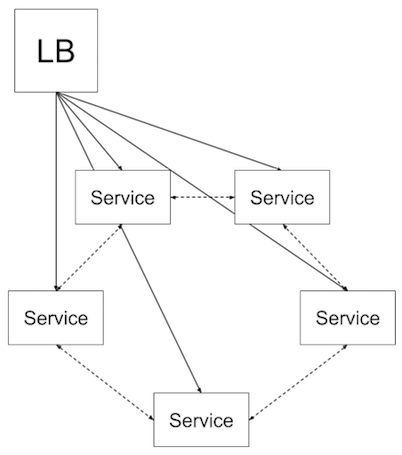 ] ??? - Single instance is possible, but availability and scalability is poor - State is distributed accross nodes somehow - LB knows the data location OR nodes can forward requests when needed --- # Microservices: stateful <br /> .center[ 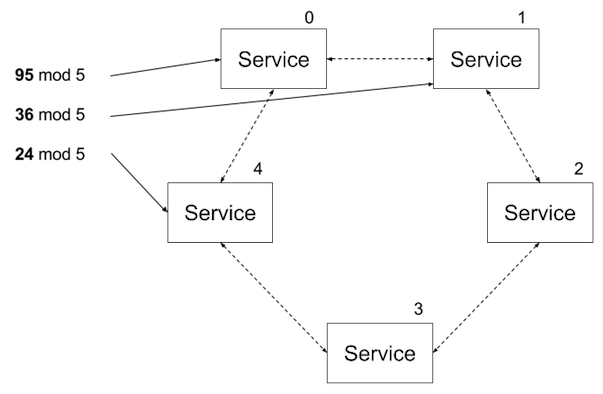 ] ??? Don't have time for ring examples and explanation --- # Microservices: stateful Benefits: - Data locality -> low latency, fast processing - Sticky consistency -> "simple" and "cheap" consistency without using consensus protocols Biggest challenges: - High availability - Scaling out --- class: center, middle # Actor systems --- # Actor systems An actor is a computational entity that, in response to a message it receives, can concurrently: - send a finite number of messages to other actors; - create a finite number of new actors; - designate the behavior to be used for the next message it receives. There is no assumed sequence to the above actions and they could be carried out in parallel. <br /> Every actor has: - A mailbox - A supervisor - Some state [optionally] ??? - Messages are sent async - It's ok to have millions of actors in one VM/node, they're cheap --- # Actor systems - Examples .left-column.column-50.text-bigger[ 📬 **Rachel** ] .right-column.column-50.text-right.text-bigger[ 📬 **Alex** ] .center.text-bigger[ 📬 **Fred** ] --- # Actor systems - Examples <br /> <br /> <br /> .center[  ] <br /> <br /> <br /> <br /> <br /> .text-left[ `Akka Concurrency by Derek Wyatt, Artima` ] --- # Actor systems - Examples .center[  ] .text-left[ `Akka Concurrency by Derek Wyatt, Artima` ] --- # Actor systems - Examples <br /> <br /> .center[  ] <br /> <br /> .text-left[ `Akka Concurrency by Derek Wyatt, Artima` ] --- class: center, middle # Akka --- # Akka Akka is an open-source toolkit and runtime simplifying the construction of concurrent and distributed applications on the JVM. Akka supports multiple programming models for concurrency, but it emphasizes actor-based concurrency, with inspiration drawn from Erlang. --- # Akka - Actors ```scala case class Greeting(who: String) class GreetingActor extends Actor with ActorLogging { def receive = { case Greeting(who) => log.info("Hello " + who) } } val system = ActorSystem("MySystem") val greeter = system.actorOf(Props[GreetingActor], name = "greeter") greeter ! Greeting("Charlie Parker") ``` - Messages are handled one by one - Immutability of messages --- # Akka - Communication ```scala class HelloActor extends Actor with ActorLogging { def receive = { case who => sender() ! "Hello, " + who } } object ConversationActor { def props(fellowActor: ActorRef): Props = Props(classOf[ConversationActor], fellowActor) } class ConversationActor(fellowActor: ActorRef) extends Actor with ActorLogging { def receive = { case "start" => fellowActor ! "it's me!" case message => log.info(message) } } val system = ActorSystem("MySystem") val helloActor = system.actorOf(Props[HelloActor]) val conversationActor = ConversationActor.props(helloActor) conversationActor ! "start" ``` --- # Actor systems and Akka - Why? So, why actors? - Simple concurrency - Clean asynchronous programming model - Great fit for event-driven systems - Resilience - Scalability --- class: center, middle # Akka Persistence --- # Akka Persistence - Overview .center[ 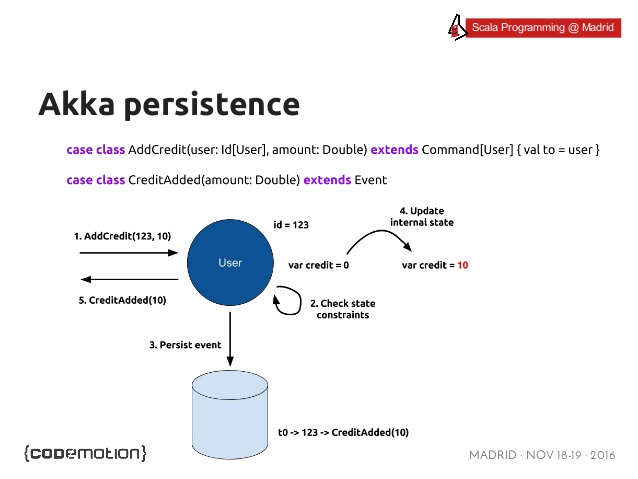 ] --- # Akka Persistence - Overview - Event Sourcing - Persistent Actor - Journal - Snapshot Has plugins for JDBC (MySQL, Postgres, ...), MongoDB, Cassandra, Kafka, Redis and more. --- # Akka Persistence - Example ```scala case class Cmd(data: String) case class Evt(data: String) case class ExampleState(events: List[String] = Nil) { def updated(evt: Evt): ExampleState = copy(evt.data :: events) override def toString: String = events.reverse.toString } class ExamplePersistentActor extends PersistentActor { override def persistenceId = "sample-id-1" var state = ExampleState() def updateState(event: Evt): Unit = state = state.updated(event) val receiveRecover: Receive = { case evt: Evt => updateState(evt) case SnapshotOffer(_, snapshot: ExampleState) => state = snapshot } val receiveCommand: Receive = { case Cmd(data) => persist(Evt(data))(updateState) case "snap" => saveSnapshot(state) case "print" => println(state) } } ``` --- class: center, middle # Akka Cluster --- # Akka Cluster - Overview .center[ 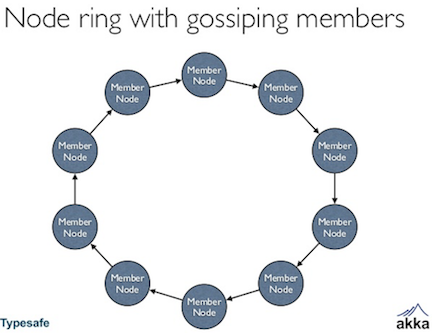 ] .left-column.column-50[ - Cluster - Node ] .right-column.column-50[ - Gossip protocol - Failure Detector ] --- # Akka Cluster - Sharding Features: - One of the most powerful Akka features! - Allows to route messages across nodes in a cluster using a sharding function (actually two) - You don't need to know the physical location of an actor - cluster will forward message to a remote node if needed - Uses Akka Persistence internally (or brand-new Distributed Data) Concepts: - Coordinator - Shard Region - Shard - Entity Entities (actors) are "activated" by receiving a first message and can be "passivated" using `context.setReceiveTimeout`. ??? - Cluster has only one coordinator as a singleton - Ideal number of shards = max(nodes) * 10 - Every shard contains set of entities --- # Akka Cluster - Sharding Counter interface: ```scala case object Increment case object Decrement final case class Get(counterId: Long) final case class EntityEnvelope(id: Long, payload: Any) case object Stop final case class CounterChanged(delta: Int) ``` --- # Akka Cluster - Sharding Counter implementation: ```scala class Counter extends PersistentActor { context.setReceiveTimeout(120.seconds) override def persistenceId: String = "Counter-" + self.path.name var count = 0 def updateState(event: CounterChanged): Unit = count += event.delta override def receiveRecover: Receive = { case evt: CounterChanged ⇒ updateState(evt) } override def receiveCommand: Receive = { case Increment ⇒ persist(CounterChanged(+1))(updateState) case Decrement ⇒ persist(CounterChanged(-1))(updateState) case Get(_) ⇒ sender() ! count case ReceiveTimeout ⇒ context.parent ! Passivate(stopMessage = Stop) case Stop ⇒ context.stop(self) } } ``` --- # Akka Cluster - Sharding Create a region on every node: ```scala val counterRegion: ActorRef = ClusterSharding(system).start( typeName = "Counter", entityProps = Props[Counter], settings = ClusterShardingSettings(system), extractEntityId = extractEntityId, extractShardId = extractShardId) ``` Sharding functions: ```scala val extractEntityId: ShardRegion.ExtractEntityId = { case EntityEnvelope(id, payload) ⇒ (id.toString, payload) case msg @ Get(id) ⇒ (id.toString, msg) } val numberOfShards = 100 val extractShardId: ShardRegion.ExtractShardId = { case EntityEnvelope(id, _) ⇒ (id % numberOfShards).toString case Get(id) ⇒ (id % numberOfShards).toString } ``` --- # Akka Cluster Sharding + Persistence = ❤️️ Akka Cluster Sharding: - Consistent hashing for all requests based on user-defined function - Automatic forwarding (from local to remote and vice versa) Akka Persistence: - Keeping internal state - Easy and fast recovery (journal + snapshots) - Event-sourcing built-in --- class: center, middle # Real-world applications --- # Real-world applications - Complex event-driven state machine with low latency API (aka **The Tracker**) - More (online gaming, data aggregation, trading, complex domains, ...) --- # Real-world applications - The Tracker Complex event-driven state machine: Consuming: - Domain Events via messaging queue (Akka Camel) Interface for querying: - HTTP API (Akka HTTP) - Websockets (Akka HTTP) Every entity has a **clientId** and they never intersect - it's a perfect use-case for sharding (clientId as a sharding key). --- # Real-world applications - The Tracker ```scala object TrackerService { case class TrackerData( accounts: Map[String, BankAccount] = Map[String, BankAccount]() ) } class TrackerService extends PersistentActor { private var state = TrackerData() private def handleMessage(message: EventMessage) { val maybeUpdatedState = message match { case b: BankAccountMessage => handleBankMessage(b) case c: ClientMessage => handleClientMessage(c) case _ => None } maybeUpdatedState.foreach { updatedState => updateState(updatedState) } } private def updateState(updatedState: TrackerData) = { state = state.copy( accounts = (state.accounts ++ updatedState.accounts).filterNot(_._2.deleted) ) } } ``` --- # Real-world applications .center[ 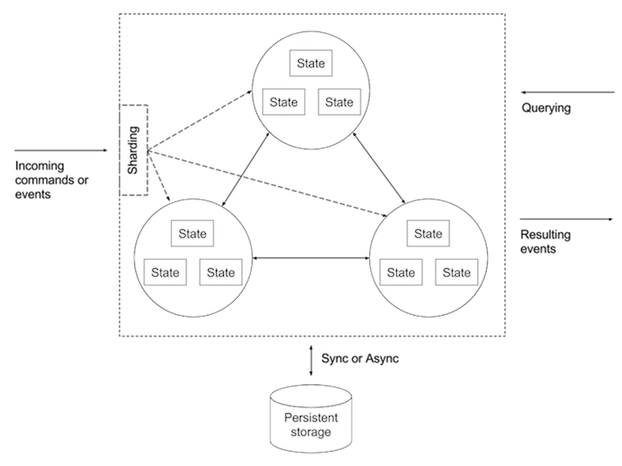 ] --- # Summary - Actor-based programming simplifies building highly scalable and reliable systems - It's not easy to build & maintain a stateful application, but you never know when it's going to be needed - Don't try to write abstractions for distributed programming from scratch (unless you're an expert) - Akka has a few great abstractions already, use them! - It's easier to build a stateful application as a microservice - smaller state size, more flexibility and great separation of concerns --- class: center, middle # Questions? @sap1ens